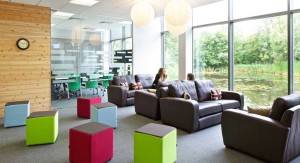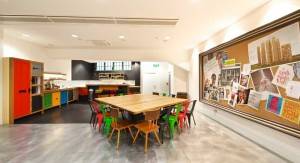 A beehive in your back-garden is hardly ideal, nor is stumbling across an ants’ nest while searching for a picnic spot. However, these swarms have become the inspiration for a revolutionary new way of working. Swarm intelligence describes how a group of people find effective solutions to difficult problems and their ability to adapt automatically to changing environments and work as a team of equals. To get the full benefits of swarm intelligence, we need to make sure that our offices have areas where staff can collaborate. There can be no rigid structures or process chains that ideas have to go through. The flow of knowledge shouldn’t be restricted. It should be allowed to flood through our businesses and offices and take no account of whether the people sharing knowledge, ideas and opinions have been with a company for five days or five years.
A beehive in your back-garden is hardly ideal, nor is stumbling across an ants’ nest while searching for a picnic spot. However, these swarms have become the inspiration for a revolutionary new way of working. Swarm intelligence describes how a group of people find effective solutions to difficult problems and their ability to adapt automatically to changing environments and work as a team of equals. To get the full benefits of swarm intelligence, we need to make sure that our offices have areas where staff can collaborate. There can be no rigid structures or process chains that ideas have to go through. The flow of knowledge shouldn’t be restricted. It should be allowed to flood through our businesses and offices and take no account of whether the people sharing knowledge, ideas and opinions have been with a company for five days or five years.
Traditional hierarchies
Swarm intelligence highlights this default pattern: we turn to hierarchies in our businesses, allowing information to filter from the bottom up. Hierarchical structure is a tried and tested system, and I’m not saying that we should look to override it – just that businesses need to become more open to flatter managerial structures.
We’re beginning to see the limitations around hierarchies: they tend to be bureaucratic, and often limit the progress of knowledge. Both of these factors can cause a dip in employee motivation.
Two things initially began the move away from hierarchical organisations: firstly the internet, and secondly the boundaries around organisations becoming more porous. The internet allowed the cost of collaboration and communication to drop significantly. Hierarchical boundaries were loosened, and resulted in greater responsiveness, greater agility and greater innovation from employees. Porous boundaries saw an emergence of peer-to-peer networking, and an increase in products that varied public value.
This change to traditional business hierarchies is encapsulated by swarm intelligence. Smart, collaborative and adaptable, this science is helping to revolutionise the way organisations are run.
Swarms in nature
We all know the classic swarms: birds, bees, termites and ants. Locusts if you’re unlucky. We can learn a great deal from these dynamic and complex collaborations existing within nature, and by applying them to our businesses, can achieve great success.
In a swarm, the motion of a collective group is a combined result of each individual acting on the basis of their  perception of their local world. This is the true science behind collaboration, and what we should aim to create in our offices. A smart swam has four characteristics: adaptive mimicking, self-organisation, diversity of knowledge, and collaboration.
perception of their local world. This is the true science behind collaboration, and what we should aim to create in our offices. A smart swam has four characteristics: adaptive mimicking, self-organisation, diversity of knowledge, and collaboration.
By highlighting each of these characteristics in a natural swarm, we can see how each can be reflected and used in business. Birds are a great example of both adaptive mimicking and self-organisation. They copy the actions of their nearest neighbour to ensure they work cohesively, and will naturally migrate when the environment becomes unproductive for them.
The honey bee exploits the diversity of knowledge that exists without their swarm, and come to conclusions and decisions through it. Scout bees will search to find new sites for bigger hives, flying up to 14 km away. They then each lead the swarm back to their choices, and the site with an 80 percent consensus will be chosen.
So, how do we as humans act like swarms? One example is the standing ovation. If a handful of people raise in their seats, more and more will. Those left seated will experience social doubts and insecurities, and rise to be part of the ‘swarm’ – so they are not seen as the different ones.
Applying swarm intelligence to the workplace
Ants, birds and bees may seem a long way from the workplace, but in reality, their intelligence and autonomous way of being can have huge positive impacts on our organisations. Swarms convey the great power, advancement and knowledge that occurs when groups come together. If you design your workplace around more collaborative spaces, then your organisation will see more productivity and efficiency.
Collaborative spaces are essential, and their necessity has often been the cause of many an office relocation or refurbishment. Shaking the normal up and letting new voices appear can lead to brilliance.
Think about your staff. Do you engage with them and hear their opinions? Do you all share ideas, and allow the resulting information to be shared across the entire organisation? A swarm does, and if we do, we can reap great rewards.
Bees have an excitement and enthusiasm for their environment. Ants keep their entire colony in optimum condition. Your workplace needs to be somewhere people are proud of.
Generation changes
Offices are becoming more and more diverse. For the first time, we potentially have four demographic groups in one workplace: your baby boomers, your generation X, your millennials. Generation Z is on the way, and you may even have some long-time veterans.
have some long-time veterans.
Each of these groups has very different characteristics – so how you can balance these differences and support them in the workplace? When we look to swarm intelligence, we see how bees take care of each other: their ageing population is looked after by the majority, with every individual characteristic being utilised to support the good of the group.
We need to leverage off the differences that exist in these demographic groups, to ensure people are working on the right projects and in the right place to emphasise their skills and abilities.
A healthy swarm is a happy swarm
Swarms automatically ensure that every member is healthy. One absent, down or ill individual has a ripple effect on others, impacting the work that needs to be done. In the office, it’s the same. Nine out of ten organisations claim that absenteeism among their staff is a significant cost to their business, with estimations calculating that sick days cost business almost GBP 10 billion per year. Mental health sufferers in the UK have also grown from 25 percent of the population 3 years ago, to 40 percent in 2014.
The British government has started to hit this head on, by looking at how health and well-being can be improved in the office. White papers, strategies and legislation have been brought in to help employees, and pushing the responsibility of care onto employers.
Making changes
So, how can we implement swarm intelligence into your workplace? Firstly, we need to consider focus spaces. Focus spaces entail open plan areas, quiet rooms, cool booths, acoustic pods and everything in between. Around 50 percent of your office ideally needs to be made up of focus space. Places where you can shut yourself away, concentrate on what you’re doing, and work in private.
Collaboration space is the next vital zone. The success of swarm intelligence rests on the ability of people to come together randomly, so having a dedicated space for this to happen is vital. Different people from different backgrounds need to come together to solve problems. Harnessing our diversity will open millions of new doors to  solutions and ideas. Collaboration spaces are accessible. They are long benches that people can gather around, they are mobile whiteboards, interactive TVs. They’re shielded away but easy to get to. 30 percent of your office needs to be collaboration space.
solutions and ideas. Collaboration spaces are accessible. They are long benches that people can gather around, they are mobile whiteboards, interactive TVs. They’re shielded away but easy to get to. 30 percent of your office needs to be collaboration space.
What about the rest of your office? That needs to be split up into meeting space and social areas. It’s time to rethink meeting rooms. Do you need doors? Could you stand up? Have meetings on sofas? Think about how we interact in meetings, and mix it up.
Social areas need to be completely separate from the rest of the office. They need to be places where employees can switch off, re-energise and recharge. They need to get away from the company and genuinely have a break. No more eating lunch at desks, or working with a sandwich in one hand.
An agile office is the best sort of office. People are constantly moving around to different spaces for different tasks. Get your employees off their seats, make sure they aren’t sat down for hours at a time. An office can be as flexible as you make it, and the more flexible it is, the more agile it will be. Maybe it’s time to consider office relocation, or perhaps all you need to do is a bit of furniture shifting.
Your intelligent office
Look at colonies, hives and swarms. On the outside, they’re eclectic with individuals seemingly going about in a random way. In reality, it’s as organised and proactive as we would like our own offices to be. Interaction is key, and that’s what we need to focus on when looking to achieve business success.
Design your office around how people come together – who is it, where is it, and why? Although this may turn your workplace upside down, it will increase productivity and motivation: the key factors in achieving the successes we wish to see.
We can learn from swarms. We can take a lot from how they organise themselves, how they work with each other and what they produce. It’s essential to take this knowledge and implement it into our own business spaces, and create an environment where an individual wants to become part of the whole.
_____________________________________
 Lee Parsons is Marketing Manager of interior design and fit-out firm Office Principles. www.officeprinciples.com
Lee Parsons is Marketing Manager of interior design and fit-out firm Office Principles. www.officeprinciples.com














January 28, 2015
How well designed office hives can foster swarm intelligence
by Lee Parsons • Comment, Facilities management, Workplace design
Traditional hierarchies
Swarm intelligence highlights this default pattern: we turn to hierarchies in our businesses, allowing information to filter from the bottom up. Hierarchical structure is a tried and tested system, and I’m not saying that we should look to override it – just that businesses need to become more open to flatter managerial structures.
We’re beginning to see the limitations around hierarchies: they tend to be bureaucratic, and often limit the progress of knowledge. Both of these factors can cause a dip in employee motivation.
Two things initially began the move away from hierarchical organisations: firstly the internet, and secondly the boundaries around organisations becoming more porous. The internet allowed the cost of collaboration and communication to drop significantly. Hierarchical boundaries were loosened, and resulted in greater responsiveness, greater agility and greater innovation from employees. Porous boundaries saw an emergence of peer-to-peer networking, and an increase in products that varied public value.
This change to traditional business hierarchies is encapsulated by swarm intelligence. Smart, collaborative and adaptable, this science is helping to revolutionise the way organisations are run.
Swarms in nature
We all know the classic swarms: birds, bees, termites and ants. Locusts if you’re unlucky. We can learn a great deal from these dynamic and complex collaborations existing within nature, and by applying them to our businesses, can achieve great success.
In a swarm, the motion of a collective group is a combined result of each individual acting on the basis of their perception of their local world. This is the true science behind collaboration, and what we should aim to create in our offices. A smart swam has four characteristics: adaptive mimicking, self-organisation, diversity of knowledge, and collaboration.
perception of their local world. This is the true science behind collaboration, and what we should aim to create in our offices. A smart swam has four characteristics: adaptive mimicking, self-organisation, diversity of knowledge, and collaboration.
By highlighting each of these characteristics in a natural swarm, we can see how each can be reflected and used in business. Birds are a great example of both adaptive mimicking and self-organisation. They copy the actions of their nearest neighbour to ensure they work cohesively, and will naturally migrate when the environment becomes unproductive for them.
The honey bee exploits the diversity of knowledge that exists without their swarm, and come to conclusions and decisions through it. Scout bees will search to find new sites for bigger hives, flying up to 14 km away. They then each lead the swarm back to their choices, and the site with an 80 percent consensus will be chosen.
So, how do we as humans act like swarms? One example is the standing ovation. If a handful of people raise in their seats, more and more will. Those left seated will experience social doubts and insecurities, and rise to be part of the ‘swarm’ – so they are not seen as the different ones.
Applying swarm intelligence to the workplace
Ants, birds and bees may seem a long way from the workplace, but in reality, their intelligence and autonomous way of being can have huge positive impacts on our organisations. Swarms convey the great power, advancement and knowledge that occurs when groups come together. If you design your workplace around more collaborative spaces, then your organisation will see more productivity and efficiency.
Collaborative spaces are essential, and their necessity has often been the cause of many an office relocation or refurbishment. Shaking the normal up and letting new voices appear can lead to brilliance.
Think about your staff. Do you engage with them and hear their opinions? Do you all share ideas, and allow the resulting information to be shared across the entire organisation? A swarm does, and if we do, we can reap great rewards.
Bees have an excitement and enthusiasm for their environment. Ants keep their entire colony in optimum condition. Your workplace needs to be somewhere people are proud of.
Generation changes
Offices are becoming more and more diverse. For the first time, we potentially have four demographic groups in one workplace: your baby boomers, your generation X, your millennials. Generation Z is on the way, and you may even have some long-time veterans.
have some long-time veterans.
Each of these groups has very different characteristics – so how you can balance these differences and support them in the workplace? When we look to swarm intelligence, we see how bees take care of each other: their ageing population is looked after by the majority, with every individual characteristic being utilised to support the good of the group.
We need to leverage off the differences that exist in these demographic groups, to ensure people are working on the right projects and in the right place to emphasise their skills and abilities.
A healthy swarm is a happy swarm
Swarms automatically ensure that every member is healthy. One absent, down or ill individual has a ripple effect on others, impacting the work that needs to be done. In the office, it’s the same. Nine out of ten organisations claim that absenteeism among their staff is a significant cost to their business, with estimations calculating that sick days cost business almost GBP 10 billion per year. Mental health sufferers in the UK have also grown from 25 percent of the population 3 years ago, to 40 percent in 2014.
The British government has started to hit this head on, by looking at how health and well-being can be improved in the office. White papers, strategies and legislation have been brought in to help employees, and pushing the responsibility of care onto employers.
Making changes
So, how can we implement swarm intelligence into your workplace? Firstly, we need to consider focus spaces. Focus spaces entail open plan areas, quiet rooms, cool booths, acoustic pods and everything in between. Around 50 percent of your office ideally needs to be made up of focus space. Places where you can shut yourself away, concentrate on what you’re doing, and work in private.
Collaboration space is the next vital zone. The success of swarm intelligence rests on the ability of people to come together randomly, so having a dedicated space for this to happen is vital. Different people from different backgrounds need to come together to solve problems. Harnessing our diversity will open millions of new doors to solutions and ideas. Collaboration spaces are accessible. They are long benches that people can gather around, they are mobile whiteboards, interactive TVs. They’re shielded away but easy to get to. 30 percent of your office needs to be collaboration space.
solutions and ideas. Collaboration spaces are accessible. They are long benches that people can gather around, they are mobile whiteboards, interactive TVs. They’re shielded away but easy to get to. 30 percent of your office needs to be collaboration space.
What about the rest of your office? That needs to be split up into meeting space and social areas. It’s time to rethink meeting rooms. Do you need doors? Could you stand up? Have meetings on sofas? Think about how we interact in meetings, and mix it up.
Social areas need to be completely separate from the rest of the office. They need to be places where employees can switch off, re-energise and recharge. They need to get away from the company and genuinely have a break. No more eating lunch at desks, or working with a sandwich in one hand.
An agile office is the best sort of office. People are constantly moving around to different spaces for different tasks. Get your employees off their seats, make sure they aren’t sat down for hours at a time. An office can be as flexible as you make it, and the more flexible it is, the more agile it will be. Maybe it’s time to consider office relocation, or perhaps all you need to do is a bit of furniture shifting.
Your intelligent office
Look at colonies, hives and swarms. On the outside, they’re eclectic with individuals seemingly going about in a random way. In reality, it’s as organised and proactive as we would like our own offices to be. Interaction is key, and that’s what we need to focus on when looking to achieve business success.
Design your office around how people come together – who is it, where is it, and why? Although this may turn your workplace upside down, it will increase productivity and motivation: the key factors in achieving the successes we wish to see.
We can learn from swarms. We can take a lot from how they organise themselves, how they work with each other and what they produce. It’s essential to take this knowledge and implement it into our own business spaces, and create an environment where an individual wants to become part of the whole.
_____________________________________